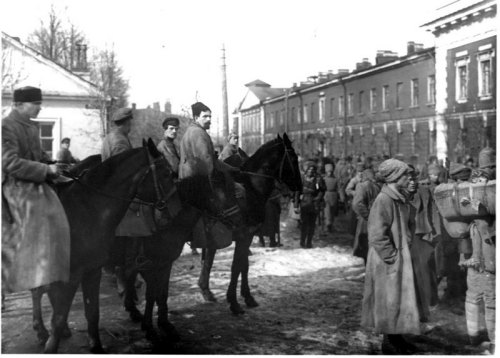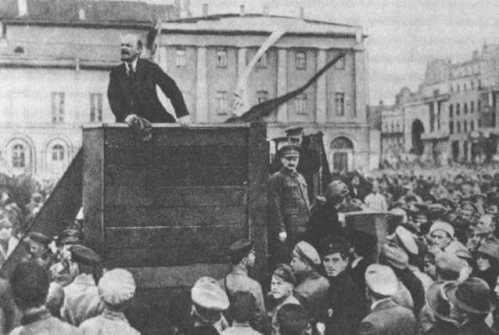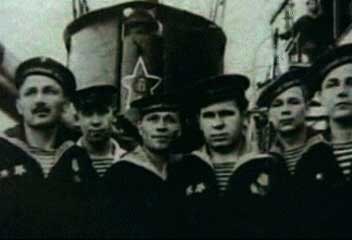Hearing the Hecklers: the Russian Revolution Revisited
In his recent book Russian Revolution in Retreat, 1920-24, Simon Pirani scours the evidence to determine whether Stalinism was always a potential of Bolshevism, or if events precipitated the vanguard's split from the revolutionary masses. Review by William Dixon
It is not too much of an exaggeration to say that we live in the aftermath of the Russian Revolution. It was an event that has helped form not just the ideas of working class movements and political groups but also bourgeois thought and its practice. It is then a matter of some importance to understand what happened in that revolution and especially to understand how it ended in the conditions we are mostly now familiar with.

Image: The Red Army entering Kronstadt after the rebellion, 1921
Of course it is a debate fraught with ideological heat. Dates are contested as to when it all went wrong ? or maybe it didn't. Simon Pirani enters this debate with a cunning resort to facts and plenty of them too. He was able to examine many of the records opened after the fall of the wall. He could access reports, even of the Cheka reports that were apparently quite honest about degrees of worker dissatisfaction and resistance.i Pirani has assembled a picture not of just what Trotsky said here or Lenin there, if you like the grand theory, but rather what lesser figures, people with more concern, perhaps, for what they'd understood the revolution to have been and how it should be defended. What we get here, then, includes the unnamed hecklers, the calls from the back, reported dutifully by those Cheka agents. The evidence he assembles is confined by choice specifically to the period 1920-1924. It is an interesting choice, for in this period we are leaving behind the distortions imposed by civil war. Distortions that were defended, by some, as necessitated by the defence of the revolution, while others could argue that this defence curtailed the choices open to the Bolsheviks. Pirani considers what happened afterwards when a certain amount of choice was open to leaders and to the working class, whether activists or at the grass roots.
This, then, does make an interesting period of analysis. So, naturally, the crude questions must arise: exactly how does the reputation of the Bolsheviks come out of this? How indeed does Lenin, or any other of the key figures, come out of this? The simple answer is they all come out of it very badly. It is, of course, important to be clear that this is not Stalinism, not yet. Here the possibility of choice, in as much as it seemed like this at the time, existed because what one might call Stalinism proper had not yet been instituted. There are important differences. Yet, already under Lenin we can see Stalinism anticipated. Pirani is cautious not to go overboard on this point and so obscure the history, but it arises anyway.
The path to Stalinism would be crassly understood if considered only in terms of some ideological preparation through the Bolsheviks. While some are tempted by this, it is a path that would not require the necessary history presented here by Pirani. Irrespective of one's views on the Bolsheviks, the revolution did indeed face formidable problems, especially in production, that posed the question of whether ‘external discipline' could be dispensed with. This is not a matter easily resolved. The explanation for capitalism lies in its development of the productive forces leading to the conditions of abundance. This development of the productive forces could be achieved through an appropriation of the surplus as value. Our experience of natural necessity is socialised through an isolation of the necessity to labour into the commodity of labour power. This gives us a socially produced necessity, and the basis for that external discipline is what we can call the law of value. Now, because scarcity is socialised it is amenable to a social solution; accumulation undermines its own basis in labour, building not just an international division of labour but the tendency for automation. Humanity then develops through scarcity into abundance. All well and good, one might say. The point though is that the arrangement of necessity and surplus works for accumulation through an external discipline. The revolution faced a problem of production, of natural necessity, that posed this question of external discipline. Could such discipline be overcome short of material abundance, indeed significantly short of the production that had previously been achieved? Or, if such discipline wasn't to be dispensed with, then the issue was what kind of regime would be exercising what kind of discipline?
What we can see in Pirani's well evidenced account is the process by which the leading elements of the Bolshevik party gradually established themselves as the ruling group in the course of grappling with these very problems. Here Pirani takes a middle ground between portraying a consistent set of ideas that lead straight from pre-revolutionary Bolshevism to Stalinism and, on the other hand, presenting a story of a party trapped by events as told by some left wing commentators. Pirani wants to say that the ideology of the party was itself formed by the changes around it. Even here, however, what Pirani observes is that the problems of the post-civil war period brought back elements of Bolshevik ideology that predated the revolution, in particular authoritarianism and statism. The events they were formed by included the special nature of capitalist development in Russia leading up to the revolution itself. It was, then, the revolution itself that formed the Bolsheviks, for a while, into a revolutionary party with mass working class membership.

Image: Lenin making a speech in Sverdlov Square at the parade of troops, leaving for the Polish front. Moscow, May 1920
While we may not be surprised that the Bolsheviks reverted to statism, it is important to understand how these ideas returned after the Bolshevik party had itself been transformed, however temporarily, by revolution. With the end of the civil war, civilian production was at 15 percent of 1913 production and with this there were serious problems in the supply of raw materials, fuel and indeed food. Absenteeism in factories was rife, but then people had to find food and fuel for themselves. Evidently, any collective means of solving the problem of under-production had been disrupted, but this did not yet mean that the possibility of collective action had passed. (It did indeed pass, however, as the Bolsheviks looked to all the ‘solutions' that denied collective action in the years that followed.) Food shortage was exacerbated as a social issue by the spread of privileged rations for officials. With compulsory labour mobilisation, introduced fully in 1920, a path was set. Characteristically, of course, it was a path in which compulsion did not equate to control, but rather imposed an external discipline which could not adequately move the system forward. Compulsion could not turn an unskilled into a skilled worker. The system developed with people and industries competing for the skilled labour while also competing for the bonus rations to keep it. Workers performing heavy, manual labour needed extra rations, but at the same time there were political demands for equalisation of rations, expressed through strikes etc., that responded to the feeling that rations were being siphoned off to privileged quarters. Yet those in steel manufacture who demanded equalisation also demanded extra food for themselves. There were no easy solutions to what was a general scarcity.
Meanwhile, of course, the food shortage was being tackled at its root through requisitioning; not a well known means of increasing production. One strike in particular seems to highlight the issues of this period. This was the tram workers' strike of Summer 1920. It was precipitated by the issue of food supply, and the strikers then went on to demand the equalisation of rations and also the right to hold citywide meetings. As Pirani points out, the strike was interesting especially because it had not been organised by any political group but by ordinary workers or, as the Moscow committee of the Bolsheviks described the leaders, ‘unconscious elements, both men and women [...] in no way different from other workers.' Given this lack of difference, clearly this was a force that had to be dealt with firmly. At each depot commissions, consisting of party cells, union and management, together no doubt making up conscious elements, started the process of ‘filtration' of the workers into separate categories: ‘conscientious workers' (presumably scabs), those with ‘unexplained absences' and ‘malicious leaders' - the latter of whom should be arrested. The arrests did take place and one of those ‘unconscious elements', Aleskie Krylov, spent a year in jail.
One might ask what kind of options were still open when a revolution had reached the point of rights being demanded? The trade union debate beginning at the Central Committee on 8 November 1920, and carrying over to the 10th Congress in 1921, illustrates the depths of the problem. There was Trotsky's plan to introduce labour compulsion so that the water transport union would work under supervision of party commissars. Of course his argument was that the transport system needed to be brought back into working order. So little was he embarrassed by his proposal that he responded to resistance from trade union activists by proposing that compulsion become a general system. The point, though, was that some form of external discipline looked necessary. Trotsky, at least, had got to the unadorned nub of the matter. Even so, external it was, and this pointed to a developing separation of the party from workers. Another form of this problem was the Bolshevik tendency to regard non-party strikers as treasonous. Ignatov, in February 1921, objected to this and rather looked to this group of workers as a force for change over the party, the proletarian vanguard, and complained that these workers had to ;drag this vanguard by the scruff of the neck, when it is a question of whether to strike or not' (p.63).

Image: Sailors at the Kronstadt naval base
In 1921 there were yet more serious workers' movements with several workers' struggles erupting, of which Kronstadt is the most famous example. Pirani is cautious in seeing here hope of a second revolution, and he appears to be right. But anyway this was a movement of workers and one can see in it, as with the 1920 strike, or the trade union debate, exactly what position the Bolsheviks came to represent. When the Bromlei workers supported the Kronstadt rebels in March 1921, they were sacked en masse. Their support had forced this drastic resolution. It is interesting, in light of these events, to report the words of Kuzmin of Elektrosal at the metal workers' conference in early February: ‘all these "gains of the revolution" are reducing us to tears'. Of course, however gloomy it might have seemed then, it still had some way to go. During the New Economic Policy (NEP), workers would appoint delegates to negotiate with their unions and even with their factory committees. Pirani devotes a necessary chapter to the emergence of labour mobilisation, organised from the top for political purposes, as real workers' participation was hollowed out. The mobilisation for church confiscation was followed by mobilisation around the Social Revolutionaries trial of 1922. A workers' state that had excluded participation in the form of workers' movements necessarily had to turn to mobilisation. That the latter example was around a political trial is enough to suggest where the ground for Stalinism was prepared. In Pirani's book we can trace this preparation at the time when its outcome did not seem inevitable, when struggles still took on the centre, when we can still hear that voice at the back; a heckler in Krasnopresnia arguing, against the 1922 church confiscations mobilisation, that ‘It would be better for you to give the surplus wealth, that was taken from the bourgeoisie, and share it with starving children.' There was no doubt by then who ‘you' was.
Being able to see this human story unfold is the great value of Pirani's book. It does, of course, raise an issue as to whether there was an alternative. Could the Bolsheviks have reacted differently for example? This is not so easy to determine. What is clear though is that the Bolshevik party faced by crises in food supply, in transport, and indeed by a very serious fall in production, confronted basic issues of necessity and so found themselves turning to external discipline. In doing so they did not stand above events but were formed by them. This is a point that is not generally acknowledged by the defenders of Bolshevism. The problem in determining whether an alternative was possible is the scope of the question, i.e. confined to Russia itself. Most people recognise the isolation of the revolution but it is not always properly assigned a role in the history. Of course that isolation was clear through the civil war, but here it is the problem of external discipline, posed of course by the collapse of production and especially the problem of food supply, by which that isolation worked its way through the whole system. We might wonder why there was no class solution but, to caricature this matter - workers making tools for agriculture were absent from work and in the countryside, looking for food. That the Bolsheviks set out to deal with this problem of co-ordination, that they were unable, simply because of their origins, to ride the market in the subsequent NEP, is the route by which that isolation produced external command, and thus Stalinism. What we can see in this book is the struggle in its early phases, before the results were fixed for years to come.
William Dixon <w.dixon AT londonmet.ac.uk> researches the nature of economics, especially in relation to morality, political considerations and the development of society
Info
Simon Pirani, The Russian Revolution in Retreat, 1920-24: Soviet Workers and the New Communist Elite, Routledge, 2008
Footnotes
i "From its founding, the Cheka was an important military and security arm of the Bolshevik communist government. In 1921 the Troops for the Internal Defense of the Republic (a branch of the Cheka) numbered 200,000. These troops policed labor camps, ran the Gulag system, conducted requisitions of food, liquidated political opponents (on both the right and the left), put down peasant rebellions, riots by workers, and mutinies in the Red Army, which was plagued by desertions." From, Wikipedia.com
Mute Books Orders
For Mute Books distribution contact Anagram Books
contact@anagrambooks.com
For online purchases visit anagrambooks.com






